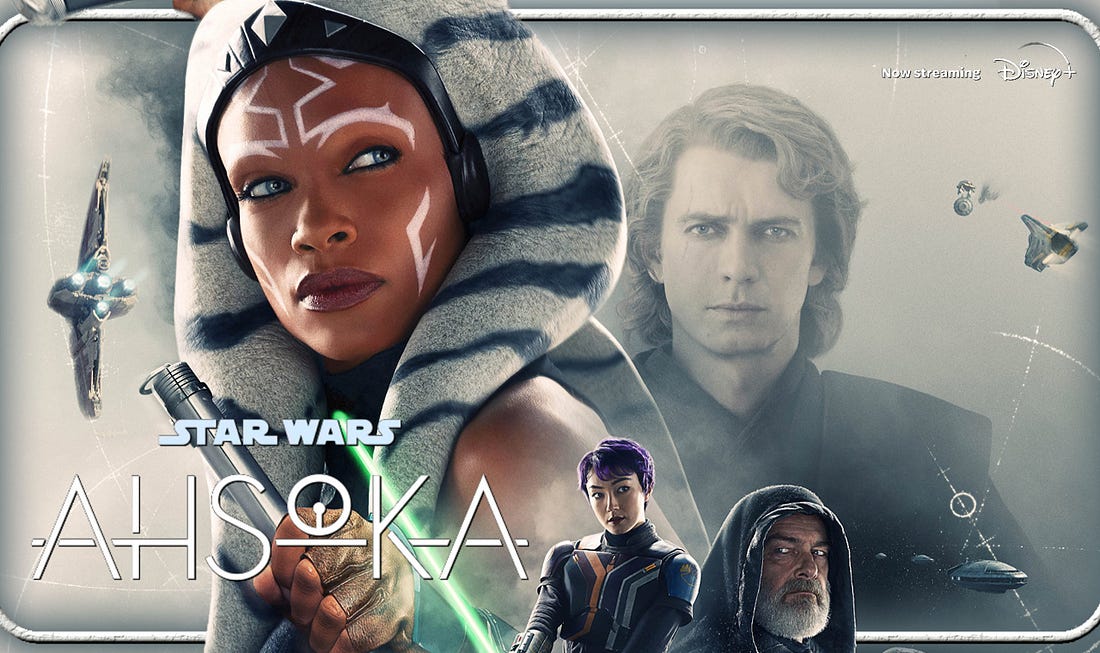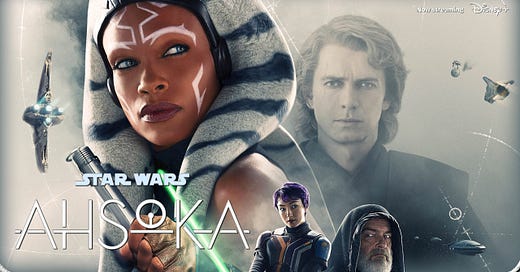Ahsoka, Created by Dave Filoni
Ahsoka presents interesting characters whose believable conflicts may just transport you to a galaxy far, far away.

Produced by John Bartnicki
Starring Rosario Dawson, Mary Elizabeth Winstead, Ray Stevenson, Ivanna Sakhno, and Lars Mikkelsen
Rated TV-14 for sci-fi violence
Distributed by Disney Platform Distribution.
The quality of recent Star Wars productions has been inconsistent. Obi-Wan Kenobi bungled the opportunity to bring back the charismatic Ewan McGregor as Obi-Wan, presenting a hapless ex-hero stumbling through a contrived story, and the third season of The Mandalorian featured the title character flying aimlessly around the galaxy for a series of over-the-top adventures that never delivered a meaningful message or overall narrative. On the other hand, the animated series The Bad Batch delivered a fascinating run of episodes exploring the early rise of the Galactic Empire and the moral alternatives facing the clone warriors who find themselves fighting for it; and Andor masterfully portrayed the experiences and decisions that turned the title character from a mercenary fighter disinterested in any cause into a principled fighter for freedom against the Empire.
Given this context, many fans were both hopeful and skeptical about the latest Star Wars installment, Ahsoka. Continuing a story line from the popular animated series The Clone Wars and Rebels, Ahsoka follows Ahsoka Tano (Rosario Dawson), the former apprentice of Anakin Skywalker, as she works to prevent the cunning and ruthless Imperial Grand Admiral Thrawn (Lars Mikkelsen) from escaping exile in another galaxy and returning to wreak havoc once more.
From the start, Ahsoka presents a clear objective (something notably missing from many recent Star Wars productions): prevent Thrawn’s return. But Ahsoka; her one-time apprentice, Sabine (Natasha Liu Bordizzo); and their ally, General Hera Syndulla (Mary Elizabeth Winstead), also have a more personal motive: recovering their long-lost friend, Ezra, who they believe is alive and stranded in the same distant galaxy as Thrawn. To achieve either goal, they must overcome resistance from their government’s senators, who don’t believe their claims about Thrawn’s impending return and dismiss their warnings as a pretense to mount a rescue mission to find Ezra.
This compelling setup makes Ahsoka far more interesting than many of the recent Star Wars shows. Virtually every character has clear motivation, and the main story is supported by interesting subplots about Sabine’s abortive Jedi training and Ahsoka’s backstory with Anakin.
Although Ahsoka doesn’t have as explicit a moral message as Andor,
it does express a clear theme throughout: the powerful role mentorship can play in a person’s life. The series deals with Ahsoka’s earlier decision to stop training Sabine as a Jedi and the impact it had on the latter’s development, as well as the effect Anakin’s transformation into the evil Darth Vader still has on Ahsoka decades later. Ahsoka develops both of these mentor/student relationships, giving viewers the opportunity to see the fully matured post-Vader version of Anakin for the first time and giving Hayden Christensen the chance to shine in the role.
Another subplot follows a “Dark Jedi,” who trains his apprentice as they work to release Thrawn from his exile, only for the two to discover important differences in their goals and ideas. Hera also acts as a mentor to her young son, who accompanies her as she tries to prevent Thrawn’s return. Even Ahsoka’s ancient droid plays a mentorship role to several other characters.
Another thing that makes Ahsoka more believable and engaging than some other Star Wars shows is Dave Filoni’s decision to limit his use of 3-D virtual studios (“The Volume”) and, instead, shoot more sequences on location or using traditional sets.1 Although the ability to surround actors with real-time visual effects gave The Mandalorian and Obi-Wan Kenobi stunning sequences and convincing alien backdrops, the overreliance of both shows on this technology led some scenes to look fake and two-dimensional, with characters limited to interacting in a confined space despite the wide-open vistas around them. Ahsoka feels much more natural thanks to its delimited use of the technology.
The storytelling in Ahsoka is certainly not seamless. Some of the later episodes get a little convoluted, introducing more characters and groups than are necessary to advance the story. Clearly, Filoni wanted to pack the show with live-action versions of characters from his work on the two earlier animated series, which sometimes comes at the expense of the story. The return of the witchlike Nightsisters, for example, will excite fans of The Clone Wars, but it does nothing to advance the story line or develop any main characters.
Nonetheless, Ahsoka is an interesting and enjoyable addition to the Star Wars universe. Particular praise goes to the performances of Lars Mikkelsen, who is positively terrifying as Thrawn; and the late Ray Stevenson, whose acting hints at a great deal more depth to his character than the series portrays. David Tennant’s charming voice-over for Ahsoka’s droid Huyang also lends the show a welcome measure of levity while continuing the Star Wars tradition of using droid characters as comic relief.
Although Ahsoka is not without flaws, it is, on the whole, compelling and exciting, a marked improvement over many recent Star Wars productions. Whereas many of the other shows were merely “content,” cooked to order for regular release without much in the way of integrated storylines, Ahsoka presents interesting characters whose believable conflicts may just transport you to a galaxy far, far away.




